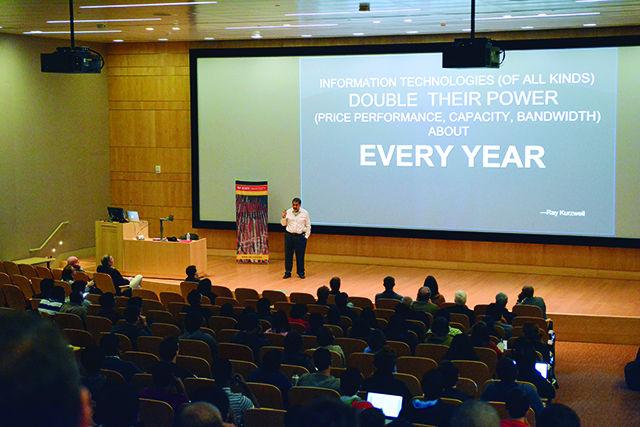One of TIME magazine’s 40 most influential minds in technology of 2013, Vivek Wadhwa, spoke optimistically about the future of technology at Hunt Library on Tuesday, predicting epidermal technology, ingestible smart pills and self-driving cars.
He began by addressing papers that claimed that we as a society have run out of ideas. Wadhwa argued that the innovation in technology is alive and well and that we have surpassed the level of technology seen in shows such as “Star Trek” and continue to grow.
“If Spock and Bones visited us today, we would laugh at them,” Wadhwa said. “Information technology of all kinds doubles in power and performance every year or two”
Wadhwa emphasized how the growth in technology has been exponential, rather than linear.
The most significant example he described was the phone. If a child of today was shown an old-school rotary phone, they wouldn’t know how to make a call. The first digital camera by Kodak was released in 1975 and shot with .01 megapixels and took 23 seconds to save. Compared to the iPhone 6S’s 12-megapixel photos, the technology has come a long way.
“What you have in your pockets right now is a billion times better… What you have in your pockets right now is more advanced than what the film studios had 15 to 20 years ago,” Wadhwa said.
And while the technology doubles in performance, prices drop dramatically. GPS chips can be purchased for about $1 nowadays, something that would be unthinkable during its debut in 1981.
After discussing the history and the milestones of tech advancements, Wadhwa changed focus to future prospects.
Going beyond smartphones, epidermal technology and devices inside your body will be possible in the 2020s. Epidermal technology will be like smartphones directly on your skin, complete with tattoo-like buttons to navigate through menus. And the medicine industry will benefit from ingestible smart pills capable of pinpointing the exact area in the body that needs treatment and high-definition videos from inside.
Wadhwa explained the concept of genomics as a situation where we have become data and our doctors are becoming software.
“Genomic medicine is tailored to individuals based on their genomes,” he said. “This turns ideas such as 3-D printing organs that cater specifically to an individual into a reality.”
Surpassing simply reading DNA, writing DNA has become a reality as well. Gene “editing” has been progressing with animals to the point where pigs have been genetically redesigned to be household pets. The military can use genomics to create exoskeletons for soldiers capable of carrying up to 900 pounds of equipment.
Wadhwa related today’s biotechnology to 1974 TV show “The Six Million Dollar Man,” in which the main character, Steve Austin, was worth $6 million because he was a cyborg with expensive bionic improvements to his vision, hearing and limbs.
“Here’s my prediction,” Wadhwa said. “Steve Austin becomes a reality by 2030. Steve Austin doesn’t cost $6 million, he costs $6,000. Why so cheap? Because as technology advances and becomes more powerful, it becomes cheaper.”
Another prediction he foresees pertains to self-driving cars. According to Wadhwa, self-driving cars will be on all of our roads in as little as five-years-time.
“That is going to be dramatic,” he said. “It is going to be traumatic for the industry because it is going to change our lifestyles.”
Along with cars, houses and other buildings will be able to be 3-D printed as well. Wadhwa claims that Hunt Library could be constructed in a couple months through the technology. And by the 2030s, he states that 3-D printing construction will be possible with space stations as well.
Going off the topic of space, Wadhwa turned toward solar energy. Ten thousand times more energy from the sun hits Earth daily than humans consume in a year. While the process of reserving solar energy is in place, the world will have more energy than it needs in fewer than 20 years. The surplus is only a matter of time and Wadhwa describes the process as being on autopilot. This will be a 100 percent clean energy replacement over oil.
“One percent means you’re halfway there,” Wadhwa said, reiterating his exponential growth ideology. The current times involve an overwhelmingly large growing technological evolution. He said that if the world ends up like the Mad Max universe or like a beautiful utopia, it is up to how we use it.








